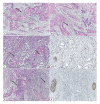Grading systems and perineural invasion in oral squamous cell carcinoma - a disease-specific survival analysis
- PMID: 39864090
- PMCID: PMC11972651
- DOI: 10.4317/medoral.26896
Grading systems and perineural invasion in oral squamous cell carcinoma - a disease-specific survival analysis
Abstract
Background: Oral squamous cell carcinoma (OSCC) is an aggressive cancer, with prognosis influenced by clinical variables as well grading systems and perineural invasion (PNI), which are associated to poorer outcomes, including higher rates of recurrence and metastasis. This study aims to evaluate OSCC using three grading systems and assess the impact of PNI and clinicopathologic parameters on patient survival.
Material and methods: Eighty-one primary OSCC samples were analyzed. Histopathological evaluations were performed utilizing Malignancy Grading of the Deep Invasive Margins, WHO grading system, and the Histologic Risk Assessment. S-100 immunohistochemistry was used to detect PNI. Five-year disease-specific survival (DSS) curves were generated using the Kaplan-Meier method, and the Cox proportional hazards model analyzed prognostic significance.
Results: Advanced clinical stage was significantly associated with reduced survival (p-value <0.001, HR = 4.07). Patients without regional lymph node involvement had better survival (p-value 0.002, HR = 0.37). Higher histologic risk assessment scores were linked to worse outcomes. Multifocal neural invasion significantly correlated with poorer survival compared to unifocal invasion (p-value 0.017, HR = 4.20). Patients undergoing surgery followed by adjuvant therapies had better survival rates.
Conclusions: Besides clinical stage and histological grade, PNI also showed to be a crucial prognostic factor in OSCC, necessitating aggressive treatment strategies.
Conflict of interest statement
The author(s) declared no potential conflicts of interest with respect to the research, authorship, and/or publication of this article.
Figures


Similar articles
-
Perineural Invasion Unveiled: Deciphering the Prognostic Impact of Diameter and Quantity Subcategories in Oral Cancer.J Otolaryngol Head Neck Surg. 2025 Jan-Dec;54:19160216251316219. doi: 10.1177/19160216251316219. J Otolaryngol Head Neck Surg. 2025. PMID: 39902557 Free PMC article.
-
Perineural invasion in oral squamous cell carcinoma: quantitative subcategorisation of perineural invasion and prognostication.J Surg Oncol. 2015 Mar;111(3):352-8. doi: 10.1002/jso.23821. Epub 2014 Oct 31. J Surg Oncol. 2015. PMID: 25363330
-
Multifocal perineural invasion is a better prognosticator than depth of invasion in oral squamous cell carcinoma.Head Neck. 2019 Nov;41(11):3992-3999. doi: 10.1002/hed.25940. Epub 2019 Sep 5. Head Neck. 2019. PMID: 31487105
-
Perineural invasion in T1 oral squamous cell carcinoma indicates the need for aggressive elective neck dissection.Am J Surg Pathol. 2013 Aug;37(8):1164-72. doi: 10.1097/PAS.0b013e318285f684. Am J Surg Pathol. 2013. PMID: 23681077
-
Impact of Adjuvant Radiotherapy in Squamous Cell Carcinoma of the Oral Cavity with Perineural Invasion.Laryngoscope. 2024 May;134(5):2019-2027. doi: 10.1002/lary.31148. Epub 2023 Nov 17. Laryngoscope. 2024. PMID: 37975480 Review.
References
-
- Anneroth G, Batsakis J, Luna M. Malignancy grading in oral squamous cell carcinoma in the floor of the mouth related to clinical evaluation. Scand J Dent Res. 1986;94:347–58. - PubMed
MeSH terms
LinkOut - more resources
Full Text Sources
Medical

